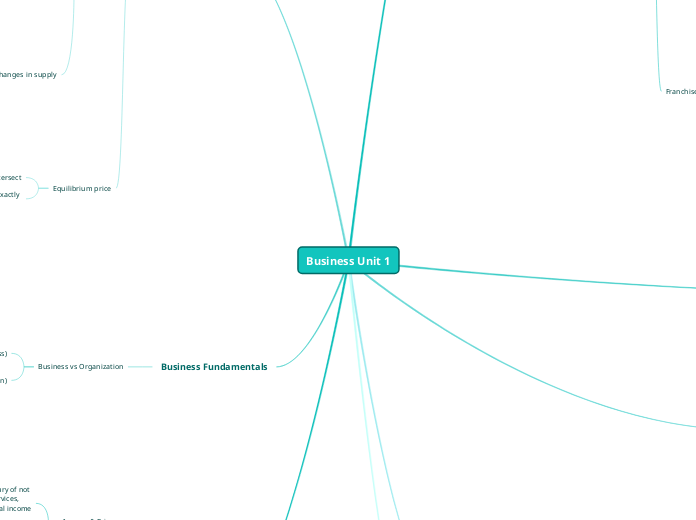Types of businesses
Privatization
A public owned business sold to a
private sector
The governemtn may stop providing
service and let the private sector
fill the gap.
Better suited for private sector
Saves government's money
Public sector
Government employers
Highly regulated, making the slower
Services are more afforable
Goal is to meet the needs of society
Employees of various levels are often
called "public servants"
Crown Corporations
Own and operated by government
Goal is to provide services to public
Private sector
Individually owned/operated businesses
Profit motive and competition drive innovation
Usually more efficient
Goal is to make profit
Terms
Needs and wants
Services
Assistance/help provided in
exchange for payment
Goods
Items that have a monetary value ($)
and can be seen/touched (tangible)
Profit
Income after the expenses are paid
Expenses
Costs for maintaining the business
Revenue
Money earned from selling G&S
Business Unit 1
Why we buy
Situational influences
State and moods? we sometimes
buy things based on our moods
Why? Unique reasons
How? Different means of purchase. Cash, card. etc
Where? we like to buy things at
places with a positive atmosphere
When? holidays, special occasions
Promotion & Advertising
Today’s algorithms on social media
platforms tailor ads to your interests
Some brands are very good at advertizement
Safety
Insurance, helmet, safety checks
Current Trends
Often applies to clothing, tech, and toys
Trends and fads change rapidly -
they may not remain the same in 1-5 years
Status
These could be expensive products
Some may choose to buy certain goods
to establish an image
Income & Price
Families with higher income
can enjoy more luxuries
Households with more income has the luxury of not only buying more expensive goods and services, but spending a smaller portion of their total income on necessities
Business Fundamentals
Business vs Organization
Not-for-profit (Organization)
Main purpose is not to make money
May still take in money to
help achieve their goals
For-profit (Business)
Produces and sells Goods & Services
with the intention of making money
Supply & Demand
Equilibrium price
At that price what consumers want to buy is exactly equal to what producers/sellers want to sell
Where demand and supply curves intersect
Supply
Changes in supply
Reasons for changes in supply
Changes in the environment/nature
(disasters and stuff)
Changes in technology
Change in the cost of production
Change in the number of producers
Decrease: producers are willing to
supply less at every price
Increase: producers are willing to
supply more at every price
Seller's entire relationship
with price has changed
Entire supply curve must also change
Quantity supplied
Is the quantity of goods and
services that businesses are
willing to supply at a given price
Direct relationship with price
When sellers/producers provide their
goods/services for consumers
Certeris Paribus: all other things being equal,
if price increases, profit increases
The higher the price increases,
the more they are willing to supply
The higher the price, the more profit
Demand
Changes in Demand
Reasons for changes in demand
Change in consumers' expectations
Change in consumer tastes/preferences
Change in population
Change in income
Decrease in demand
Same price, less demand
Increase in demand
Same price, higher demand
Consumers' entire relationship
with price has changed
Not the result of price changes
Quantity demanded
Can be cause by prices changing
Changes will remain on the demand curve
The demand curve itself remains unchanged
The quantity that consumers are
willing/able to purchase at a given price
Created by
Access to G/S
Relevant Prices
Available supply of G/S
Awareness that the good exsists
Maslow in business
Needs vs wants
Role of consumers
Marketplace
The location where producers
and consumers come together
Consumers
People who use goods and services
Producers/sellers
business that provides goods and services
Maslow's heirarchy of needs
EVERYONE STARTS AT THE BOTTOM AND
WORKS THEIR WAY UP, NO SKIPPING
Physiological needs
Safety and security
Love and belongingness
Self-esteem
Self-actualization, creativity, meaningfulness
Factors of Production
Information
Capital resources
Financial and Long-lived (machinery, tools, buildings) resources
Management
Human resources
Uses people's skills
Raw materials
Semi processed resources
Natural resources
Creating goods and services
A shortage in a factor a factor of production
will lead to higher prices or production of
an alternative
Types of Business Ownership
Franchise
Less decision making control
Part of profits goes to head office
Expensive Franchise fees
Recieve training and support from head office
Shared marketing costs (head office does ads)
Brand recognition
Cooperatives
Only way to raise money is to attract new members (as well as selling your own G&S for profit)
Board of Directors is sometimes unpaid
Many different viewpoints to
consider when decision making
Management issues/disputes
Sacings offered by type of cooperative
(keep prices down for consumers)
patronage returns (profits divided up between members)
Limited peronal liability
One vote per member - everyone has equal say
Members share the same goal
Equally owned by its various members
Corporations
Public corporations
Sell shares/bonds to the public
Can have any number of shareholders
Private corporations
Shares/bonds not sold to the public
Must obtain funds privately
Limited in the number of shareholders
they may have (50 max)
Complicated decision making
(CEO & Board of Directors)
Extensively record keeping
Closely regulated
Timely, costly, and complicated.
paperwork to set up
For shareholders: one vote per share
Might be easier to get loans
Easy to sell ownership
When corp needs $: issue shares
Partnerships
Limited partners
Limited liability
They can only lose what they invest
Responsibilities are limited to amount invested
General partners
Each partnership MUST have at least one general partner
Unlimited liability
Responsible to the day-to-day operations
Challenging to sell personal share
Unlimited liability for general partners
Shared profits
Shared decision-making
Conflict between partners
Shared responsibilities
Easier loans
Have a legal document
No legal distinction between partnership and owners
General partners have all the same
responsibilities as a sole proprietor
Are formed by 2+ individuals
Sole proprietorship
Cons
Owner is responsible for all debts and losses
(unlimited liability)
Business is legally tied to the owner
- Can come after personal assets when sued
Pros
All profits goes to owner
Easy to establish
One owner









